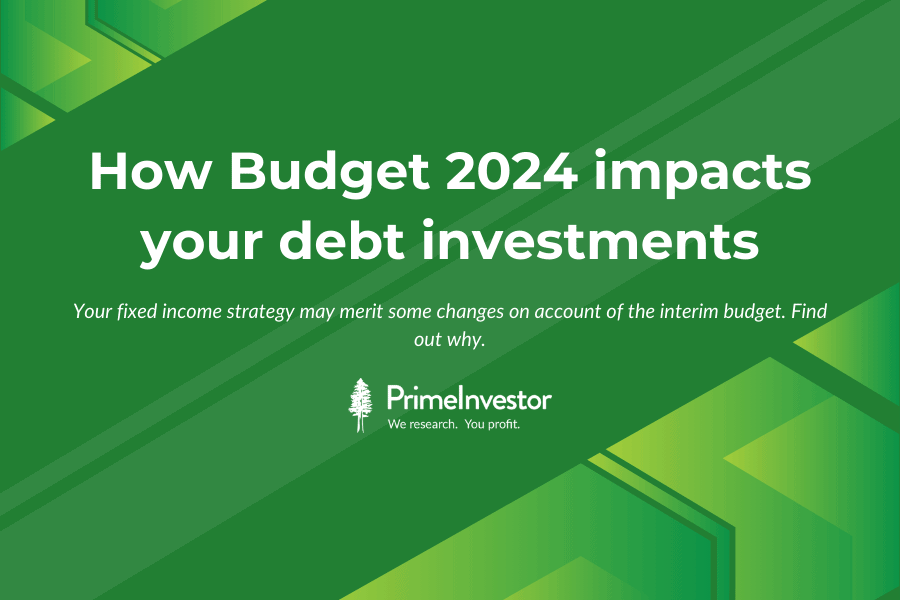For long, stock market investors have been eager trackers of the Union Budget for the sops that it could hand out to companies they own. But with indirect tax changes now left to the GST Council, the ability of the budget to materially alter the prospects of individual companies or sectors has dwindled. Corporate tax rates have already been cut to the bone in 2019.

The budget however remains an important event for debt investors, because it outlines how much the government, the elephant in the Indian bond market, will borrow. The 2024 interim budget turned out to be quite bullish for bonds. This may merit changes to your fixed income strategy. Here’s why.
Budget 2024 – why it is bullish for bonds
If you noticed, the stock market was bored stiff with the budget speech, but the bond market was excited. With a sharp rally in the 10-year government security (g-sec), its yield fell by 10 basis points from 7.14 per cent to 7.04 per cent on budget day. Four takeaways from the budget set off this rally.
- FY24 deficit within target: In India, fiscal deficit targets mostly exist only on paper, with very few governments actually trying to meet them. The NDA government in the last couple of years has been an exception. It is actually expected to meet its fiscal deficit target this fiscal. In the budget last year, he Centre’s fiscal deficit target was set at 5.9% for FY24. The budget now shows that the actual number could be about 5.8% (based on revised estimates). This is a surprise because the fiscal deficit percentage has the nominal GDP as its denominator. When setting the target at 5.9% last year, the budget had assumed a nominal GDP growth of 10.5%. But the actual nominal GDP growth has turned out much lower at 8.9%. That the Centre managed to keep within the fiscal deficit target despite a shrinking denominator, shows that it is serious about living within its means.
- FY25 deficit lower than expected: The Indian government’s fiscal deficit used to hover at about 3.5-4% until FY20. But with its spending shooting up by 25% during Covid, it shot up to 9.5% in FY21. After Covid, the Centre swore that it would wrestle down the fiscal deficit to 4.5% by FY26. But with the number staying above 6% for two years, bond markets doubted if this could really be achieved. Markets expected the current year’s budget to set a target of 5.3% for FY25, a 50-basis-point cut from FY24. But the interim budget went one up on this by setting its deficit target at 5.1%, a 70 basis-point-cut. Given that the government has actually been meeting its budget targets lately, markets now believe that fiscal consolidation, which will push down the deficit to 4.5% by FY26, can really materialise.
- Borrowings flatten out: Why should the bond market care so much about whether the government sticks to its fiscal deficit targets? Because the fiscal deficit decides how much the Centre will borrow in the coming year. The table below shows how Central government borrowings have shot up post-Covid and the flattening out this year.
The Indian bond market is not very large or deep and the Indian government (Centre and States) is by far the biggest supplier of bonds on it. When the government floods the market with bonds, there’s lesser room for others – like companies or banks – to borrow. Government security yields set the floor for market interest rates. So when the government announces a large supply of bonds in the coming year, yields shoot up not only for g-secs but other corporate bonds that trade at a premium to g-secs. High market interest rates can also prevent the MPC from cutting rates, or hold back the market from responding to rate cuts.
This is why the budget announcement that the Centre will not jack up its borrowings next year triggered a fall in yields across the board.
- Global bond inclusion: While the supply of Indian g-secs is set to moderate this year, the demand for them is expected to spike because of Indian g-secs getting included into global bond indices such as the JP Morgan GBI EM index with effect from June 2024. (Read our article on inclusion of India in the JP Morgan index and its impact on debt market). India also seems to be on a fiscal consolidation path at a time when the Chinese economy is troubled and Western economies particularly the US are showing no signs of mending their fisc. This should make Indian g-secs more attractive to foreign investors.
Interest Rate outlook
All of the above suggest that Indian bond yields, led by g-secs, can decline significantly from their recent highs over the next year. The decline could also materialise earlier than the second half of 2024 projected in our annual Prime debt outlook. A material decline in market interest rates could also prompt the MPC to consider rate cuts earlier than expected.
We think that these developments would impact interest rates on medium to long term debt instruments (3 years plus) more than short-term instruments. Short-term interest rates may continue to be determined by liquidity conditions in the market, which are currently tight. But should the yield on 5-10 year g-secs fall to 7% or below, short term rates cannot hold above this for too long, as it would invert the yield curve.
Debt investment strategy
This slight change in outlook will mean the following for your debt strategy.
- If you are retiree or to-be-retiree looking to lock into long-term income through long-term g-secs, government fixed income options, guaranteed income plans, annuity plans or deferred annuity plans of insurers, it is best not to delay this decision, as the IRRs that such plans offer today, may not last.
- If you are an investor with a 5 year plus horizon looking for a long-term allocation for the debt portion of your portfolio, you should act now on accumulating 10-year constant maturity funds. Though their recent returns have been unimpressive, their returns will get better with falling market rates. However, do brace for higher short-term volatility in returns from such funds, as foreign investors begin to participate in these bonds in a bugger way.
- As we expect liquidity to remain relatively tight, money market and short duration funds remain good options to park emergency and short term money.
- If you are a regular income seeker or a retiree dependent on FD income, this is a good time to lock into 4-5 year FDs from top rated NBFCs and good quality banks. This will protect you from reinvestment risk as rates fall. Please wait for our alert on the changes we will make to. We do not expect any changes to the policy rates in the MPC meet on February 8. However, we will be revising Prime Deposits to add those with more attractive rat current options. Kindly check your mails for an alert on changes in Prime Deposits.






9 thoughts on “How Budget 2024 impacts your debt investments”
Hi Aarati,
1. Thanks for this timely update.
2. Looking forward to your views on Gold investments, MFs / ETFs, in light of Zerodha’s launch of Gold ETF, other Gold related launches, particularly with markets on high’s and expected volatility in second half of 2024.
Regards
Sure shall write one soon.
Waiting for the changes in Prime Deposits, any update?
The Prime Deposits section is updated for our latest views on rates
Two questions
1) I usually invest emergency corpus only in liquid funds as money market funds and short-term funds seem a tad risky as returns is not my focus really. Do you still recommend money market funds in this scenario?
2) For someone who is investing in PPF and the corpus is due to mature, keeping the current scenario in mind, would you recommend them to move out into constant maturity funds or a hybrid fund?
Money market funds are a good option if safety is your priority because they invest only in treasury bills and not corporate paper. Constant maturity funds would be a good choice for the PPG momey
for long term debt allocation– a person of 40 yrs expected retirement after 20 yrs what is the best option?
I recently came across g sec c strip option ie 0% bonds with maturity of around 20 yrs.
Since it is 0% interest bond no tax liability in accumulation stage. On maturity it is LTCG with 20% tax with indexation so it is quite helpful. Yield is 7%. Fully safe.
Can you share your views? Also any better alternative? Will 10yr constant maturity fund will be a better option from expected return angle?
In your debt fund selection, you have nothing for such a long tenure.
We have not come across the instrument you are referring to, so unable to say. Constant maturity gilt funds will work in the long run and may deliver upto 7.5/8% but taxation is at slab rates on returns at maturity.
Well written and easy to read article. Thank you.
Comments are closed.